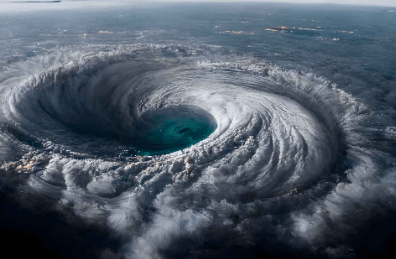How Naming Hurricanes Enhances Awareness and Ensures Safety

Hurricanes have been a subject of observation for centuries, but the structured naming of these powerful storms began in the early 20th century. Initially, meteorologists used latitude-longitude coordinates to track them, which often resulted in confusion, especially when multiple storms were active simultaneously. To streamline communication, a formal naming system was established. The practice of naming hurricanes started with female names during World War II, chosen by military meteorologists monitoring storms over the Pacific. This method became official in 1953 when the United States adopted female names for Atlantic storms. By 1979, the naming convention evolved to include male names, promoting gender equality and making it easier for the public to track and remember storms. This evolution underscores the growing understanding of hurricane behavior and the need for efficient communication.
Purpose of Naming Hurricanes
The primary goal of naming hurricanes is to prevent confusion and ensure clear communication. Assigning a specific name to a storm makes it easier to discuss, remember, and report. This is particularly crucial when multiple tropical systems occur simultaneously. The naming system facilitates better coordination between meteorologists, broadcasters, and the public, ensuring timely warnings and updates that are vital for preparedness. The effectiveness of this system is evident in the increased awareness and response rates during named storms. By naming hurricanes, meteorologists can more effectively communicate the storm’s severity and potential impacts, aiding in public preparedness and safety.
How Naming Improves Communication
Naming hurricanes significantly enhances communication. Instead of using confusing numbers, a name like Hurricane Andrew or Hurricane Michael is easier for meteorologists to issue warnings about and for the public to understand and follow. This streamlined communication ensures that emergency information is conveyed effectively, potentially saving lives. Additionally, named storms can be easily tracked in news stories and social media, maintaining community vigilance. The clarity and simplicity of named storms highlight the importance of this naming convention in modern weather reporting. Improved communication enables quick decision-making during critical times, facilitating timely evacuations and preparations.
Role of Media in Hurricane Awareness
The media’s role in hurricane awareness is crucial. Once a hurricane is named, it becomes the focus of weather broadcasts, online news, and social media platforms. Named hurricanes receive more focused and frequent coverage, helping to disseminate critical information quickly and efficiently. For example, The Weather Channel and other weather-focused media outlets provide extensive coverage, tracking the storm’s path, potential impact, and safety tips. This widespread dissemination of information ensures that even those not actively seeking updates stay informed about the storm’s developments, enhancing public safety. The media plays a vital role in demystifying meteorological information and making it accessible to a broader audience, fostering a culture of preparedness.
Public Preparedness and Safety Measures
Naming hurricanes is vital for public preparedness. When a storm is named, it emphasizes its seriousness and prompts individuals and communities to take necessary precautions. Residents in potentially affected areas are more likely to heed evacuation orders, stock up on essential supplies, and secure their homes. According to the Federal Emergency Management Agency (FEMA), hurricanes significantly contribute to community and individual readiness. Public service announcements, emergency alerts, and preparedness campaigns are more effective when referencing a named storm, as people tend to pay more attention to and act on these warnings. Being prepared reduces the risk of injuries and fatalities and mitigates the economic impact on affected communities.
Psychological Impact of Naming Hurricanes
Beyond facilitating communication and preparedness, naming hurricanes has a psychological impact. A name can humanize the storm, making it a more tangible and pressing threat. This heightened sense of awareness and urgency can lead to quicker and more decisive public action. The naming process also brings a standardized method to the chaos, providing a semblance of order during a crisis. By giving storms a name, meteorologists create a narrative around them, which helps the public perceive and react to the threat more seriously. This psychological framing is crucial in ensuring that safety measures are taken promptly. Moreover, the personalization of storms through naming draws community attention and spirit, fostering collective responsibility and preparedness.
Read also:- Andre Hakkak’s Success: The Unsung Influence of His Wife
Real-World Examples
Real-world examples such as Hurricane Katrina and Hurricane Sandy illustrate the effectiveness of naming hurricanes. Hurricane Katrina is etched in public memory due to its devastating impact and the intense media coverage and public attention it garnered. The name itself became a rallying point for relief efforts and emergency response. Similarly, Hurricane Sandy’s name helped focus resources and aid, ensuring the storm’s aftermath was addressed swiftly and efficiently. These examples highlight the efficacy of the naming system and its role in framing the historical significance of these events.
The Future of Hurricane Naming
As climate change leads to more extreme weather conditions, the practice of naming hurricanes will likely evolve. Future improvements could involve integrating new technologies and more sophisticated tracking systems. Advancements in satellite imagery and predictive analytics might make the naming process more precise and timely. Moreover, names might be chosen more strategically to enhance communication and preparedness. The continuous evolution of this practice ensures that it remains a vital tool in weather forecasting and public safety, adapting to new challenges and leveraging technological advancements to improve efficacy. Digital platforms and AI innovations could also make real-time information dissemination more effective, ensuring community safety and responsiveness.